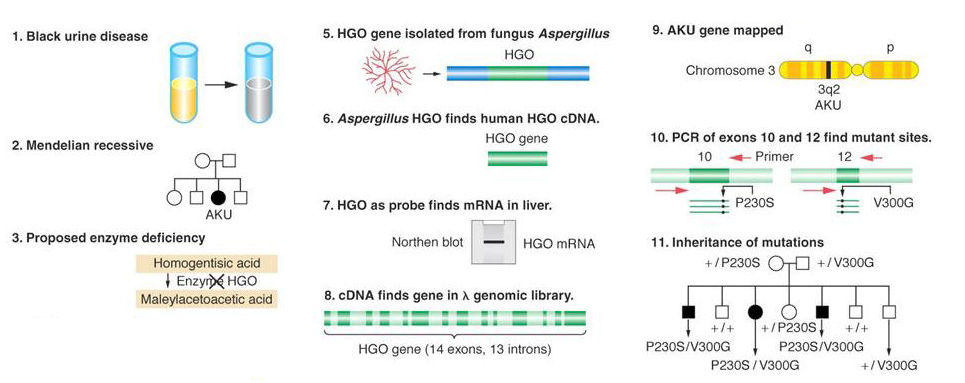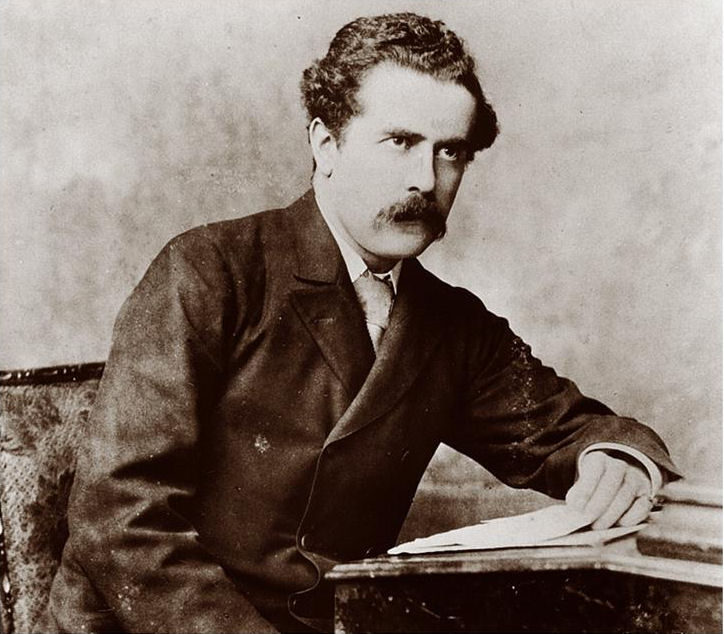
Classical Genetics versus "Reverse Genetics":
Genetics and molecular biology of Alkaptonuria, an inborn error of metabolism:
Archibald Garrod in 1902 observed the "Black Urine Disease"
in his patients (Step
1) . From the
pattern of inheritance (pedigree)
observed in families under his care (Step 2), he deduced that the disease was inherited as a
simple recessive trait, in
the manner described by Mendel,
whose work at the time had been recently rediscovered.
Chemical analysis of their urine suggested a biochemical
basis, that the disease was caused by build-up of a substance
called alkapton (Step
3). Garrod had no knowledge of the biochemical nature of genes. We now call
alkapton Homogentisic Acid, and recognize the enzyme
that metabolizes it as Homogentisic Acid Oxidase (HGO).
Given an organisms like Aspergillus in which a number of metabolic mutants have been identified, the homologous HGO gene provides molecular probes to identify expression of the human gene in the liver (Steps 5-7). A cDNA probe made from the human mRNA identifies a clone of the gene in a phage Lambda library (Step 8). Bioinformatic analysis of ORFs identifies the expressed exons and intervening introns. The gene locus is then localized to a small region of the long arm of human Chromosome 3 within the 3q2 band (Step 9). Detailed analysis of the region shows a variety of SNP mutations that map to specific mutations in particular exons (ex., Pro to Ser at residue 230) (Step 10). On investigation, some members of the families studied have an unusual phenotype, "Black Urine Disease." DNA sequencing of those individuals in a pedigree similar to those studied by Garrod demonstrates that parents and offspring have the expected phenotypes for their observed genotypes.
Garrod's analysis in Steps 1-3 is classical Genetics: he observed the pattern of inheritance of the phenotype in order to infer the the nature of the biochemical genotype. The molecular analysis running backward from Step 11 is "Reverse Genetics": detailed study of the gene locus genotype predicts how it produces a disease phenotype.
Homework: Explain in detail the pedigree in Step 11: How do the alleles P230S and V300G identified in Step 10 result in the phenotypes shown in Step 11
Given an organisms like Aspergillus in which a number of metabolic mutants have been identified, the homologous HGO gene provides molecular probes to identify expression of the human gene in the liver (Steps 5-7). A cDNA probe made from the human mRNA identifies a clone of the gene in a phage Lambda library (Step 8). Bioinformatic analysis of ORFs identifies the expressed exons and intervening introns. The gene locus is then localized to a small region of the long arm of human Chromosome 3 within the 3q2 band (Step 9). Detailed analysis of the region shows a variety of SNP mutations that map to specific mutations in particular exons (ex., Pro to Ser at residue 230) (Step 10). On investigation, some members of the families studied have an unusual phenotype, "Black Urine Disease." DNA sequencing of those individuals in a pedigree similar to those studied by Garrod demonstrates that parents and offspring have the expected phenotypes for their observed genotypes.
Garrod's analysis in Steps 1-3 is classical Genetics: he observed the pattern of inheritance of the phenotype in order to infer the the nature of the biochemical genotype. The molecular analysis running backward from Step 11 is "Reverse Genetics": detailed study of the gene locus genotype predicts how it produces a disease phenotype.
Homework: Explain in detail the pedigree in Step 11: How do the alleles P230S and V300G identified in Step 10 result in the phenotypes shown in Step 11

Archibald Garrod (ca. 1908)